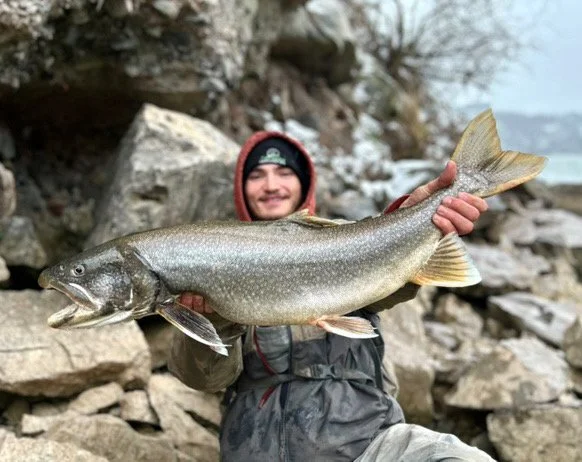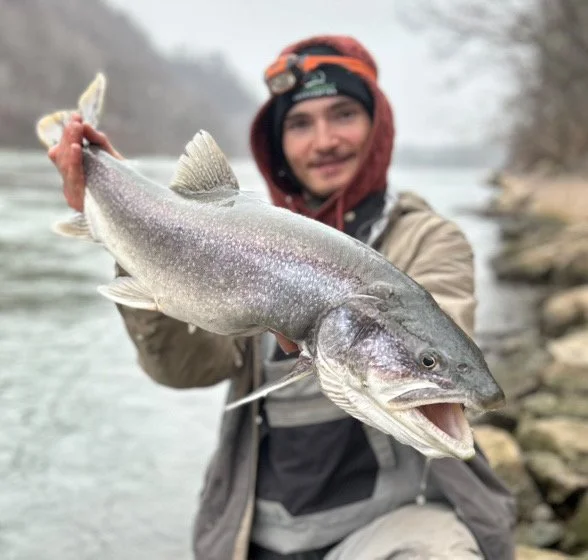Lake Trout 101: Finding, Catching, and Fighting These Monsters on the Fly
With: 7ft_3wt
We recently caught up with Teddy ( 7ft_3wt ) who shared his deep passion for Lake Trout fishing. He’s been chasing these heavy hitters on the fly rod for years, and his experiences bring a fresh perspective on what makes the fight of a Lake Trout so unique. In this interview, we dive into the best ways to find, catch, and land these massive fish, plus the gear and flies that work wonders for these cold-water beasts.
About Teddy
I grew up in Erie County, NY, near some of the famed Lake Ontario and Lake Erie watersheds. Growing up I would spend time riding my bike around with a spinning rod in hand and a pocket full of tackle to any nearby body of water I could find from a map. On one of my early excursions I was at a local creek and was watching this fly fisherman catch fish after fish after fish. I was intrigued by how technical he was making it look and how effortlessly he was getting these fishto bite. I introduced myself and asked if I could see what he was using. He then proceeded to show what at the time to me looked like a tiny clump of hair. I was in amazement and could not believe that clump of hair was catching more fish than my Mepps spinner. I went home that day with a passion for fly fishing and knew that’s what I wanted to focus on.Years later and countless numbers of hours spent with the fly rod in hand I can truly say that the fight of a fish on a fly rod does not come close to any other tackle. From a fly line getting wrapped in your feet to a big wind knot on light tippet, the chaos of fly fishing exceeds any other.
Lake Trout Introduction
This leads me to Lake Trout fishing. Salvelinus Namaycush, better known as Lake Trout, are a species of Char that are native to Northern USA and many parts of Canada. With a history of overharvesting the population of this native fish has decreased significantly, especially in the Great Lakes region.
The U.S. Fish and Wildlife Service stocks over 500,000 one-year-old lake trout every spring to help bring back the once declining population. In my opinion, fighting a Lake Trout on a fly rod is one of the most unique fights you could ever feel. You'll be swinging through a run and think you bumped into a rock until your line takes off to the bottom and all you feel is sheer weight and massive head shakes. I once heard someone say a Laker on the fly rod is like fighting a school bus.
Finding Lake Trout and Reading Water
Lake Trout prefer cold water and can be found in many deep rivers and lakes.When it comes to finding these fish on the fly rod, simplicity is key. In the Fall, Winter, and Spring, Lakers can be found close to the banks chasing baitfish and utilizing the rocky shorelines to spawn. When I
first started Lake Trout fishing I was very intimidated by the depth and the size of the river I was on. It took me a while to realize where the fish were actually sitting. Lakers are notoriously known for being lazy fish that do not like to sit in too swift of a current. Looking for current seams and places where the water is noticeably more still than the rest will help you tremendously. These current breaks will usually be right near the shore near boulders or embankments.
Gear and Fly Patterns
Lake Trout are not picky fish by any means and if you are in the right spot at the right time almost anything looks like food to these fish. Egg patterns like the Estaz egg or Jeff Blood egg are used frequently and are often successful. My preferred method is swinging streamers. Patterns like the Peanut Envy and Bunny Leech have also proven to be very effective. Lakers can be hefty so 7, 8, or 9 weight rods are ideal. I keep it simple with a WF floating line but sink tips and skagit heads can also work well. Depending on the depth I will usually end up with a couple split shots on to help my streamer get near the bottom.
Common Mistakes
The biggest mistake I see people make when lake trout fishing is overcomplicating things. Don't worry so much about how long your leader is or what fly you're using. Even though these things do matter, focus more on your timing with seasons and water conditions. The most important part is to put yourself in front of some fish. After you do that the rest will come.
Follow Me Here
https://www.instagram.com/7ft_3wt/
Get Your Flies From
https://www.instagram.com/hairytrout_tackleshop/
https://www.instagram.com/mcnamaras_fly_shop/






